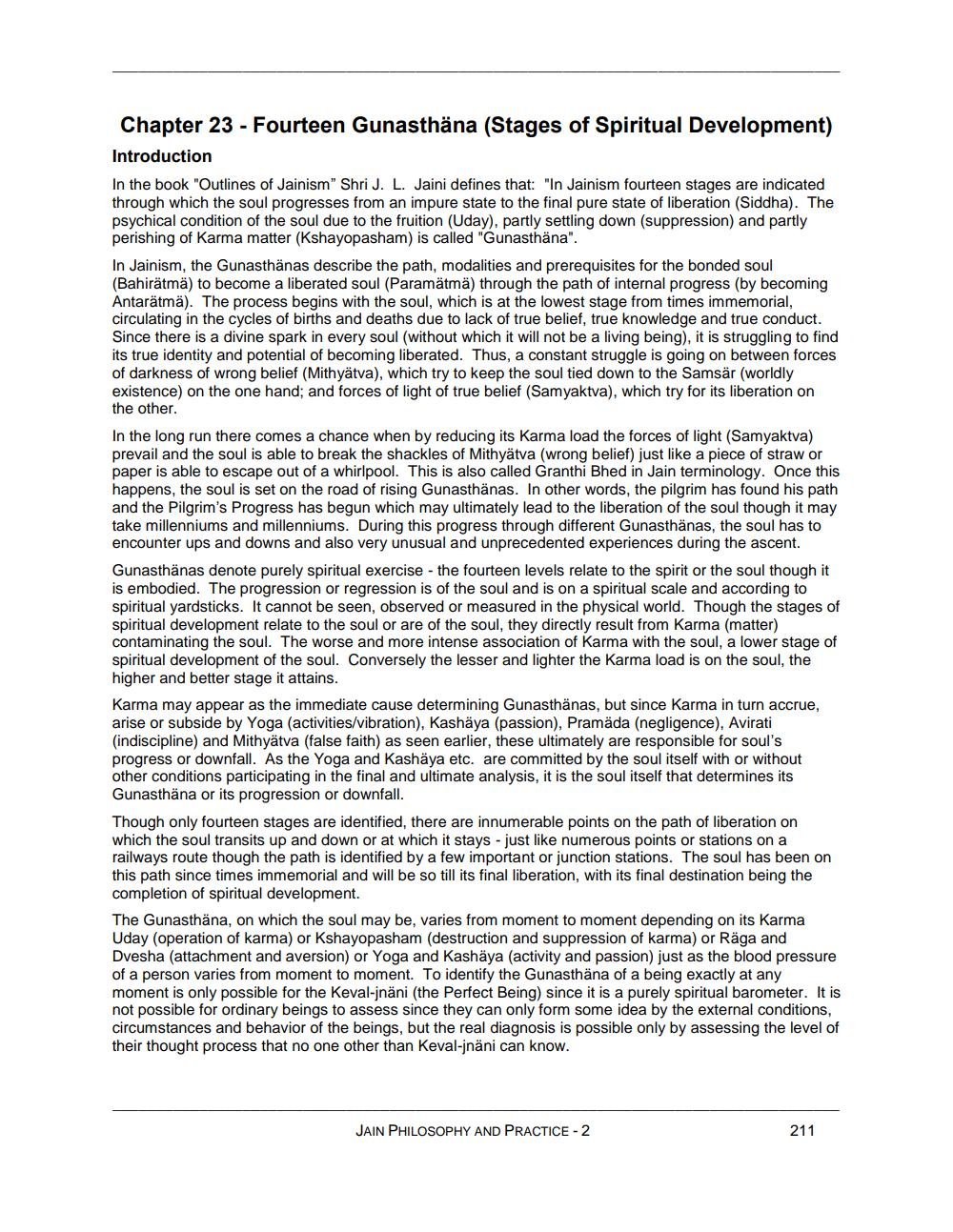________________
Chapter 23 - Fourteen Gunasthäna (Stages of Spiritual Development)
Introduction
In the book "Outlines of Jainism" Shri J. L. Jaini defines that: "In Jainism fourteen stages are indicated through which the soul progresses from an impure state to the final pure state of liberation (Siddha). The psychical condition of the soul due to the fruition (Uday), partly settling down (suppression) and partly perishing of Karma matter (Kshayopasham) is called "Gunasthäna".
In Jainism, the Gunasthänas describe the path, modalities and prerequisites for the bonded soul (Bahirätmä) to become a liberated soul (Paramätmä) through the path of internal progress (by becoming Antarätmä). The process begins with the soul, which is at the lowest stage from times immemorial, circulating in the cycles of births and deaths due to lack of true belief, true knowledge and true conduct. Since there is a divine spark in every soul (without which it will not be a living being), it is struggling to find its true identity and potential of becoming liberated. Thus, a constant struggle is going on between forces of darkness of wrong belief (Mithyätva), which try to keep the soul tied down to the Samsär (worldly existence) on the one hand; and forces of light of true belief (Samyaktva), which try for its liberation on the other.
In the long run there comes a chance when by reducing its Karma load the forces of light (Samyaktva) prevail and the soul is able to break the shackles of Mithyätva (wrong belief) just like a piece of straw or paper is able to escape out of a whirlpool. This is also called Granthi Bhed in Jain terminology. Once this happens, the soul is set on the road of rising Gunasthänas. In other words, the pilgrim has found his path and the Pilgrim's Progress has begun which may ultimately lead to the liberation of the soul though it may take millenniums and millenniums. During this progress through different Gunasthänas, the soul has to encounter ups and downs and also very unusual and unprecedented experiences during the ascent.
Gunasthänas denote purely spiritual exercise - the fourteen levels relate to the spirit or the soul though it is embodied. The progression or regression is of the soul and is on a spiritual scale and according to spiritual yardsticks. It cannot be seen, observed or measured in the physical world. Though the stages of spiritual development relate to the soul or are of the soul, they directly result from Karma (matter) contaminating the soul. The worse and more intense association of Karma with the soul, a lower stage of spiritual development of the soul. Conversely the lesser and lighter the Karma load is on the soul, the higher and better stage it attains.
Karma may appear as the immediate cause determining Gunasthänas, but since Karma in turn accrue, arise or subside by Yoga (activities/vibration), Kashaya (passion), Pramäda (negligence), Avirati (indiscipline) and Mithyätva (false faith) as seen earlier, these ultimately are responsible for soul's progress or downfall. As the Yoga and Kashaya etc. are committed by the soul itself with or without other conditions participating in the final and ultimate analysis, it is the soul itself that determines its Gunasthäna or its progression or downfall.
Though only fourteen stages are identified, there are innumerable points on the path of liberation on which the soul transits up and down or at which it stays - just like numerous points or stations on a railways route though the path is identified by a few important or junction stations. The soul has been on this path since times immemorial and will be so till its final liberation, with its final destination being the completion of spiritual development.
The Gunasthäna, on which the soul may be, varies from moment to moment depending on its Karma Uday (operation of karma) or Kshayopasham (destruction and suppression of karma) or Räga and Dvesha (attachment and aversion) or Yoga and Kashaya (activity and passion) just as the blood pressure of a person varies from moment to moment. To identify the Gunasthäna of a being exactly at any moment is only possible for the Keval-jnäni (the Perfect Being) since it is a purely spiritual barometer. It is not possible for ordinary beings to assess since they can only form some idea by the external conditions, circumstances and behavior of the beings, but the real diagnosis is possible only by assessing the level of their thought process that no one other than Keval-jnäni can know.
JAIN PHILOSOPHY AND PRACTICE - 2
211




